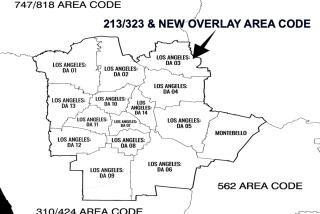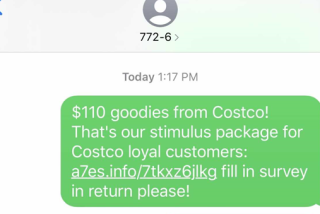New Rules Will Free Up Phone Numbers
- Share via
WASHINGTON — Calling a nearby neighbor used to be a seven-digit endeavor. But in more and more cities, it’s become an 11-digit ordeal as area codes multiply to cope with separate lines for computers, cell phones, faxes and pagers. And with the country running out of eligible area codes, those numbers could get even longer.
To ease the pressure for new area codes, the Federal Communications Commission adopted rules Friday to free up unused numbers that phone companies hold in reserve. The FCC’s action also dismantles a monopoly-era system for allotting digits, taking into account new local phone competition and burgeoning demand for telecommunications services.
“Around the country, people are plugging into the network and using it more,” said FCC Chairman Bill Kennard. While that’s a good thing, he said, it means that outdated methods for distributing numbers must be changed.
Some projections forecast that the country could run out of area codes within the next eight to 10 years, requiring callers to punch in more numbers than they do now. Each area code change forces people to learn new dialing patterns, and many must upgrade equipment and reprint business cards, stationery and advertising. Alarm companies also must reprogram autodialing equipment.
In its most sweeping action, the commission undid a decades-old system of allocating numbers to local carriers in blocks of 10,000 for every billing region they wish to serve, replacing that with a 1,000-number system.
The problem with the old system was that if a carrier had only 100 customers in a given region, the remaining 9,900 numbers of the block were tied up, unavailable for users elsewhere.
The commission laid out Friday a national plan to shift to giving local phone companies 1,000 numbers at a time, a system that will apply to wireless companies by 2002 as well.
Others measures the FCC adopted include taking back those numbers that carriers are holding but not using.
So they can’t hoard numbers in the future, phone companies will also have to show their actual demand for new numbers, rather than their projected need, before they are given new ones.
Ten states already are using new approaches to conserve numbers.
In California, telephone companies starting Friday got access to a new pool of numbers in the 310 area code. That’s because carriers have sent back some 767,000 unused numbers for redistribution.
In Maine, regulators were told two years ago they would have to add an area code. But when the state examined the situation, it discovered 3 million unused numbers that had been assigned to carriers.
The FCC let the state require carriers to use at least 75% of their allocation or be within six months of running out before they can request more.
“We’re not trying to keep people from numbers they need,” said Trina Bragdon, staff attorney with the Maine Public Utilities Commission. But the state wants to make sure of the need before allotting numbers.
The numbering system, which also covers Canada and the Caribbean, began with 86 area codes in 1947. An additional 64 were gradually added through 1994, according to the North American Numbering Plan Administration.
But then the area codes rapidly increased: 23 more in 1996, another 44 in 1997, 28 in 1998, 42 in 1999.
On the Net: North American Numbering Plan Administration site: https://www.nanpa.com
Federal Communications Commission: https://www.fcc.gov
More to Read
Sign up for Essential California
The most important California stories and recommendations in your inbox every morning.
You may occasionally receive promotional content from the Los Angeles Times.













